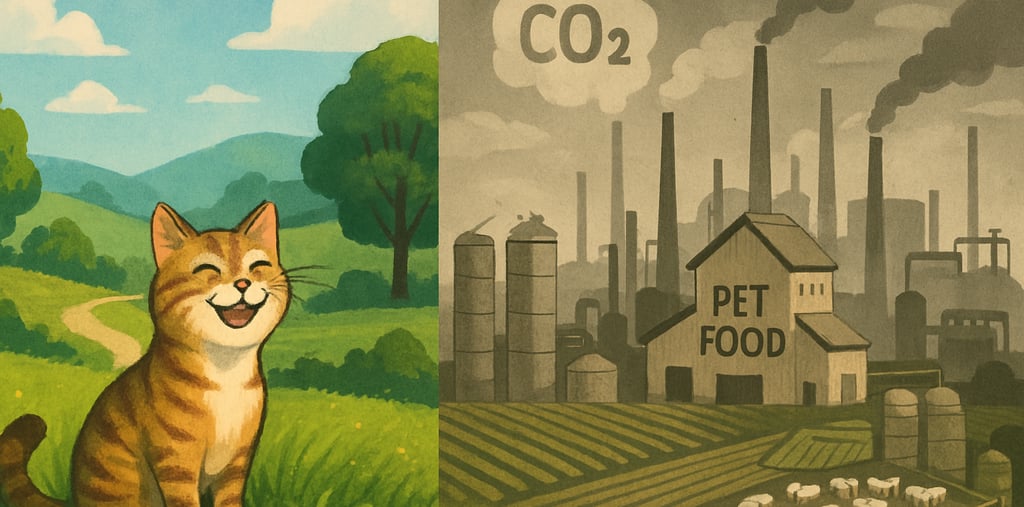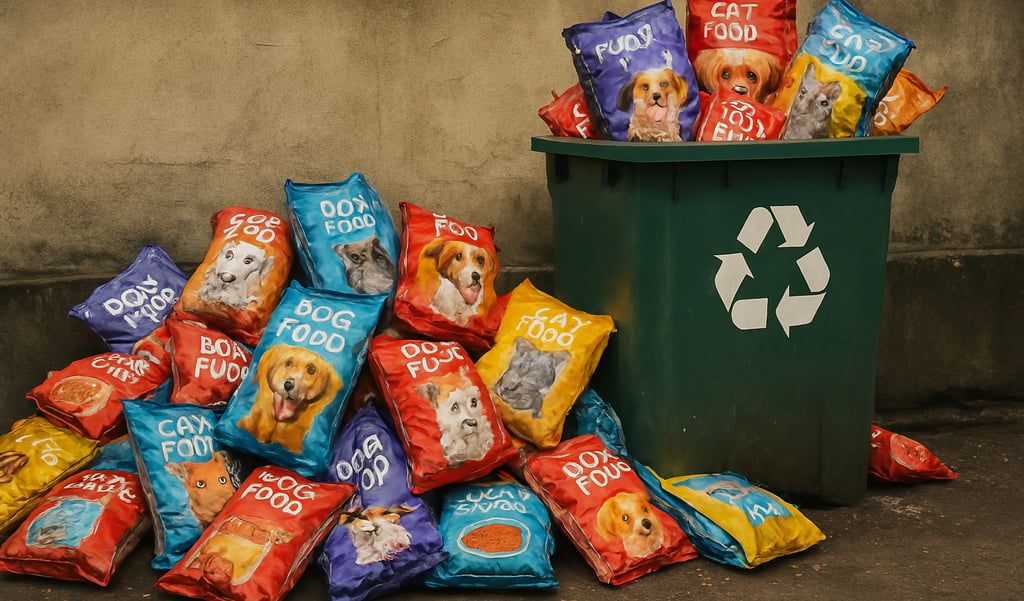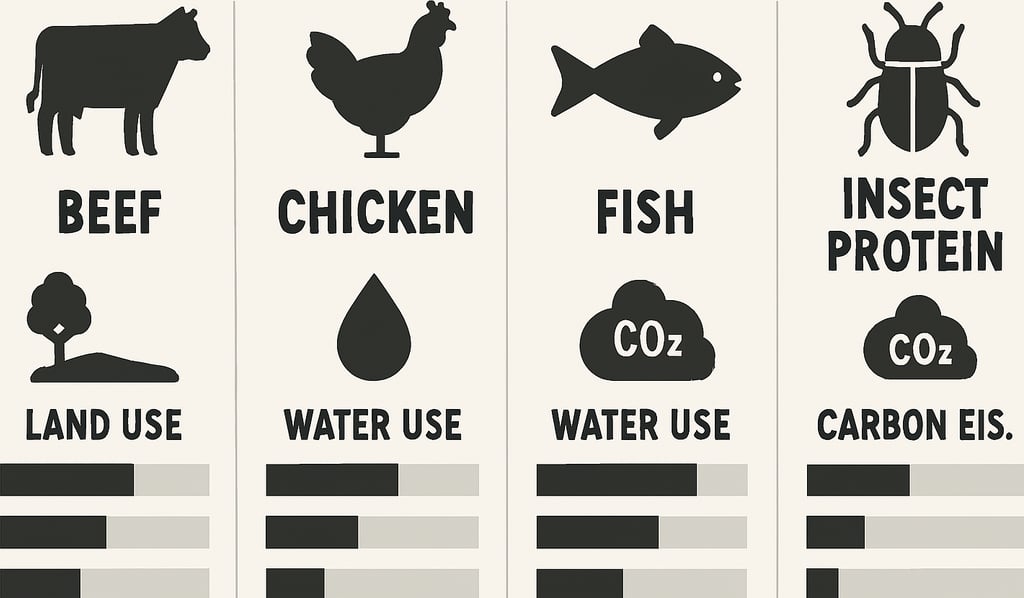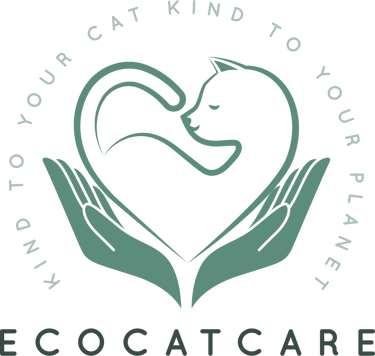The Environmental Impact of Your Cat's Diet (And How to Reduce It)
NOURISHING YOUR CAT & THE PLANET


As devoted cat parents, we strive to provide the best for our feline companions, from cozy beds to engaging toys and, most importantly, nutritious food. However, have you ever paused to consider the environmental pawprint of your cat's diet? The production of pet food, particularly meat-based cat food, has significant ecological consequences, contributing to issues like greenhouse gas emissions, land and water use, and biodiversity loss. Understanding these impacts is the first step towards making more sustainable choices that benefit both our beloved pets and the planet.
The Heavy Pawprint of Meat-Based Diets
Cats are obligate carnivores, meaning their dietary needs are met by consuming animal flesh. This biological necessity inherently links their diet to the livestock industry, a major contributor to environmental degradation.
Greenhouse Gas Emissions: The livestock sector is responsible for a substantial portion of global greenhouse gas emissions, primarily methane from animal digestion, nitrous oxide from fertilizer use for feed crops, and carbon dioxide from land-use change (e.g., deforestation for pasture). The production of meat for cat food contributes directly to these emissions.
Land Use: Raising livestock requires vast amounts of land for grazing and for growing feed crops like corn and soy. This can lead to deforestation, habitat destruction, and loss of biodiversity as natural landscapes are converted to agricultural use.
Water Consumption: The meat industry is also a significant consumer of water resources. Water is needed for hydrating animals, irrigating feed crops, and processing meat. In many regions, this puts a strain on already scarce freshwater supplies.
Overfishing and Marine Ecosystem Disruption: Many cat foods, especially wet varieties and treats, contain fish. The demand for fishmeal and fish oil in pet food contributes to overfishing, which depletes fish populations, damages marine ecosystems, and affects the livelihoods of communities dependent on sustainable fishing. Unsustainable fishing practices, such as bottom trawling, can also destroy vital marine habitats like coral reefs.
Packaging Waste: Beyond the ingredients themselves, cat food packaging contributes to landfill waste. Plastic pouches, cans, and large bags, while convenient, often have limited recyclability or are made from non-renewable resources.
How to Reduce Your Cat's Dietary Environmental Impact
While the challenges are significant, there are numerous ways eco-conscious cat owners can lessen the environmental impact of their cat's diet without compromising their nutritional needs.
Choose More Sustainable Protein Sources: Not all meats are created equal in terms of their environmental footprint. Poultry (like chicken and turkey) generally has a lower impact than red meats like beef and lamb due to more efficient feed conversion and lower methane emissions. When choosing fish-based foods, look for products made with sustainably sourced fish. Certifications like the Marine Stewardship Council (MSC) blue tick can help identify these options. Consider novel proteins like insect-based cat food, which is emerging as a highly sustainable and nutritious alternative, requiring significantly less land, water, and feed than traditional livestock.
Opt for Brands with Sustainable Practices: Support pet food companies that are transparent about their ingredient sourcing and demonstrate a commitment to sustainability. This might include using renewable energy in their manufacturing, sourcing ingredients from regenerative agriculture, or investing in by-product utilization (using parts of animals that might otherwise go to waste, provided they are high quality and clearly named).
Portion Control and Reducing Waste: Overfeeding not only contributes to pet obesity but also means more food is consumed, and therefore produced, unnecessarily. Feed your cat the appropriate amount for their age, size, and activity level. Store food properly to prevent spoilage and reduce food waste.
Consider Foods with Plant-Based Proteins (Carefully and as a Supplement): While cats are obligate carnivores, some modern cat foods incorporate a small amount of plant-based proteins alongside animal proteins to meet certain nutritional profiles. If considering these, ensure the primary protein sources are still animal-based and that the food is complete and balanced, formulated by veterinary nutritionists. This is a nuanced area, and the bulk of a cat's protein must come from animal sources.
Minimize Packaging Waste: Look for cat food sold in recyclable packaging (e.g., cans, some types of bags – check local recycling guidelines). Buying in bulk can reduce the overall amount of packaging per unit of food, but ensure you can use it before it expires to avoid food waste. Some smaller, local pet food suppliers might offer refill options.
DIY Treats with Sustainable Ingredients: Making your own cat treats allows you to control the ingredients and choose sustainable options. Simple treats can be made from leftover cooked chicken (unseasoned) or sustainably sourced fish.
Support Research and Innovation: The pet food industry is continually evolving. Stay informed about new research into sustainable pet food ingredients and manufacturing processes. Supporting companies that invest in these innovations can help drive positive change.
Reducing the environmental impact of your cat's diet is a journey, not a destination. By making thoughtful choices about the type of food you buy, the brands you support, and how you manage food resources, you can significantly lessen your feline friend's ecological pawprint. Every small change contributes to a larger movement towards a more sustainable future for pets and the planet.
CTA Teaser: Our comprehensive Eco-Conscious Cat Feeder guide provides a complete roadmap to feeding your cat sustainably without compromising their health. Discover detailed comparisons of protein sources, brand recommendations, and practical tips for minimizing your cat’s dietary impact. Make informed choices for a healthier cat and a healthier planet.




Sustainable Cat Care
At EcoCatCare, we provide resources that help cat parents discover how sustainable choices can create healthier, happier lives for their feline companions while contributing to a healthier planet.
EcoCatCare © 2025. All rights reserved
